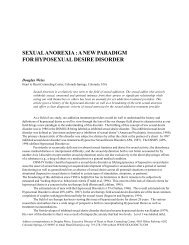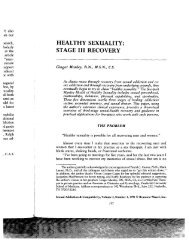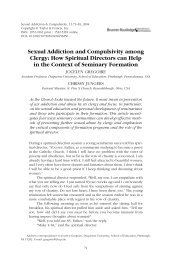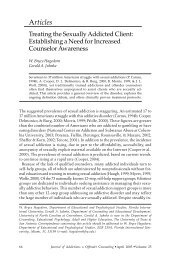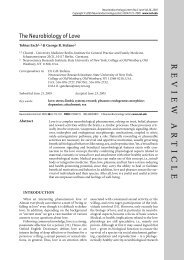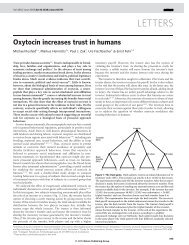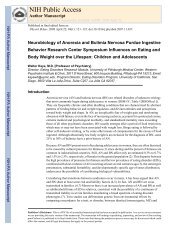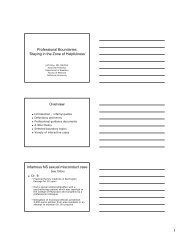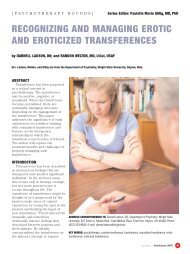Attachment
Attachment
Attachment
You also want an ePaper? Increase the reach of your titles
YUMPU automatically turns print PDFs into web optimized ePapers that Google loves.
clinicians, had noticed in young children’s response to<br />
loss that there was a somewhat predictable sequence of<br />
behaviors: first, the child protested with anger and<br />
rage; second, the child became depressed and showed<br />
despair; and finally, the child became detached from<br />
people and the environment. 3<br />
Since Bowlby’s early work on attachment starting<br />
in the ’50s, it has been believed that attachment and<br />
bonding may well be essential keys to explaining the<br />
most fundamental psychological and social problems.<br />
Bowlby called the way a child begins to understand his<br />
or her surroundings “inner working models,” and the<br />
model has been found to influence a child’s perceptions<br />
from early childhood on into adulthood. 4<br />
An abused<br />
child may develop a working model of distrusting all<br />
relationships.<br />
Ainsworth’s research on child abuse shows the<br />
effect abuse has on the development of a child far into<br />
the future. 5<br />
Studies have shown that infants whose<br />
relationships with their mothers are more secure are<br />
more competent as toddlers, preschoolers and public<br />
school students. 6<br />
Nurturance the mother experienced<br />
in her own childhood predicted the quality of the<br />
attachment she developed with her own infant. 7<br />
Abusive mothers have been shown to be more<br />
emotionally sensitive to their infants than neglectful<br />
mothers, but less sensitive than non-abusive mothers. 8<br />
There is perhaps a greater risk for children of mothers<br />
who, although they are aware of what the child needs<br />
and wants, do not respond.<br />
More specific to trauma and abuse, research has<br />
also shown that abused and neglected children are<br />
more likely to show avoidance and resistance to their<br />
mothers after even a brief separation. Abused children<br />
have also been found to be more difficult to raise, while<br />
neglected children are more passive, and children in<br />
supportive environments are more cooperative.<br />
In psychology, as in medicine, we are much quicker<br />
to identify a problem than the causes or the solutions to<br />
the problem. It is clear that our society has many<br />
dysfunctional members. There are well over one million<br />
men and women in our jails and prisons. The majority<br />
of men and women in our correctional institutions were<br />
abused children, and many have lived a life of antisocial<br />
behavior. Our drug and alcohol programs are full<br />
with waiting lists; domestic violence, divorce and<br />
broken homes are at the highest level in our history.<br />
Poverty, unemployment and hopelessness exist in<br />
abundance in modern America. Although causative<br />
cultural phenomena can be identified, failure in our<br />
society is experienced one person at a time and one life<br />
at a time. The study of early dispositional patterns<br />
developed in childhood — what can be called secure<br />
and insecure attachment — provides insight into the<br />
ability of some people to overcome life’s obstacles while<br />
others seem unable to do so.<br />
Physical, Emotional and Social Factors<br />
Three components of attachment theory are physical,<br />
emotional and social dimensions. Physical factors<br />
influencing attachment involve aspects of human<br />
physiology including hormones and the central nervous<br />
system. The importance of physical touch and other<br />
senses have already been mentioned. Emotional bonds<br />
are developed (or not developed) rapidly in infants, and<br />
once established, they are long-lasting. The role of<br />
emotions in the attachment process appears to be to<br />
assist in appraisal of the infant’s internal organismic<br />
states and of the external environment.<br />
Social reciprocity is the purpose of attachment.<br />
Physical sensations combine with the infant’s<br />
emotional/intuitive appraisal, producing a behavior that<br />
is social or anti-social. Only if the child can accurately<br />
assess the affective state of another person can they<br />
productively participate in a social interchange.<br />
Instinct<br />
A major influence upon attachment is instinct. The first<br />
instincts of primary importance are the instincts to<br />
survive, to be social and to be adaptable to the<br />
environment. Instincts are not restricted to infants;<br />
they also affect the mother. Deviations in evolutionary<br />
adaptedness, as Bowlby describes instinctive behaviors<br />
that don’t achieve the desired results, can produce<br />
maladaptive behavior patterns. When this occurs, a<br />
negative cycle develops with the child slipping further<br />
and further away from the instinctive goal of<br />
connection.<br />
<strong>Attachment</strong> Theory Behaviorally Defined<br />
<strong>Attachment</strong> theory has been primarily defined in<br />
behavioral terms and can be summarized in eight<br />
important steps:<br />
1. Social responses are first elicited by a wide array<br />
of stimuli. This gradually narrows and after<br />
several months becomes confined to one or<br />
more individuals.<br />
2. A bias develops to respond more to certain<br />
kinds of stimuli than to others.<br />
3. The more experiences of positive social<br />
interaction with a person, the stronger the<br />
attachment becomes.<br />
4. Exposure to human faces produces<br />
discrimination in the attachment figure.<br />
5. The timing of attachment is critical and needs to<br />
develop during the sensitive period within the<br />
first year.<br />
6. The sensitive phase begins sometime after six<br />
weeks (this position has subsequently been<br />
criticized).<br />
7. At the end of the sensitive period, the infant<br />
responds to non-attachment figures with a fear<br />
response, making it difficult to attach after one<br />
year.<br />
8. Once a child becomes strongly attached, they<br />
prefer this person over all others despite<br />
separation.<br />
Whether or not the above processes remain<br />
functional for attachment may depend on the final<br />
phase of four attachment processes in infants: a)<br />
preferences to look at certain patterns and movements;<br />
b) discrimination of one stimuli over another; c)<br />
preference for the familiar; and d) resulting positive<br />
Continued on<br />
page 10<br />
Paradigm • Fall 1998 7



